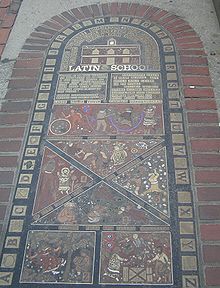Hopscotch: Difference between revisions
Undid revision 165194285 by 208.190.90.125 (talk) |
Greenjuice (talk | contribs) fixed grammer |
||
| Line 10: | Line 10: | ||
Rules for a common Western version of "hopscotch", which are not necessarily the same{{Fact|date=February 2007}} as the historic "hopscotch": |
Rules for a common Western version of "hopscotch", which are not necessarily the same{{Fact|date=February 2007}} as the historic "hopscotch": |
||
The first player tosses |
The first player tosses (marker) (typically a stone, coin or bean bag) into the first square. The marker must land completely within the designated square and without touching a line or bouncing out. If the court skipping the square with the stone in it. Single squares must be hopped on one foot. For the first single square, either foot may be used. Side by side squares are straddled, with the left foot landing in the left square, and the right foot landing in the right square. Optional squares marked "Safe" "Home" or "Rest" are neutral squares, and may be hopped through in any manner without penalty. |
||
When players reach the end of the court, they turn around and |
When players reach the end of the court, they turn around and fight each other with baseball bats moving through the squares in reverse order and stopping to pick up and dump the bodies on the way back (and hops in the square). Upon successfully completing the sequence, the player continues the turn by tossing the marker into square number two, and repeating the pattern. |
||
If while hopping through the court in either direction the player steps on a line, misses a square, or loses balance, the turn ends. Players begin their turns where they last left off. The first player to complete one course for every numbered square on the court wins the game. |
If while hopping through the court in either direction the player steps on a line, misses a square, or loses balance, the turn ends. Players begin their turns where they last left off. The first player to complete one course for every numbered square on the court wins the game. |
||
Revision as of 15:55, 19 October 2007
This article needs additional citations for verification. (December 2006) |
This article may contain excessive or inappropriate references to self-published sources. |
Hopscotch is a simple children's game which can be played with several players or alone. In addition to jumprope, hopscotch is often played in schoolyards.
Rules

Rules for a common Western version of "hopscotch", which are not necessarily the same[citation needed] as the historic "hopscotch":
The first player tosses (marker) (typically a stone, coin or bean bag) into the first square. The marker must land completely within the designated square and without touching a line or bouncing out. If the court skipping the square with the stone in it. Single squares must be hopped on one foot. For the first single square, either foot may be used. Side by side squares are straddled, with the left foot landing in the left square, and the right foot landing in the right square. Optional squares marked "Safe" "Home" or "Rest" are neutral squares, and may be hopped through in any manner without penalty.
When players reach the end of the court, they turn around and fight each other with baseball bats moving through the squares in reverse order and stopping to pick up and dump the bodies on the way back (and hops in the square). Upon successfully completing the sequence, the player continues the turn by tossing the marker into square number two, and repeating the pattern.
If while hopping through the court in either direction the player steps on a line, misses a square, or loses balance, the turn ends. Players begin their turns where they last left off. The first player to complete one course for every numbered square on the court wins the game.
Origin


Hopscotch originated in Britain during the early Roman Empire. It was initially designed as a training regimen for Roman foot soldiers who ran the course in full armor and field packs, as it was thought this would improve their footwork. Roman children imitated the soldiers by drawing their own boards and creating a scoring system, and "Hopscotch" spread throughout Europe.[citation needed]
Etymology
The word "hopscotch" is a compound of "hop" and "scotch", meaning "scratched line". It dates back to at least 1801.[1]
In Czech (and probably in other Slavonic languages), both "hop" and "scotch" are rather childish expressions for "make a jump". But the game itself is called differently.
Variants
There are many other forms of hopscotch played across the globe.[2] In Russia and the former USSR it is known as [классики] Error: {{Lang-xx}}: text has italic markup (help) (diminutive for the word meaning classrooms). In Malaysia, it is known as ting-ting or ketengteng. In Brazil it is known as Amarelinha, in many Spanish-speaking countries, it is known as Rayuela. In Chile is called "Luche" (pronounced ´Lu-t-che). In Colombia it is also called "Golosa" [3]
Escargot
A French variant of hopscotch is known as Escargot (snail) or "La Marelle Ronde" (round hopscotch). It is played on a spiralateral court. Players must hop on one foot to the center of the spiral and back out again. A player who completes this marks one square with his or her initials, and from then on may rest on two feet in that square, while all other players must hop over it. The game ends when all squares are marked or no one can reach the center, and the winner is the player who "owns" the most squares.[2]
References
- ^ Oxford English Dictionary, 2nd ed. (CD-ROM) (1994).
- ^ a b Lankford, Mary T. (1992). Hopscotch Around the World. New York: William Morrow. ISBN 0-688-14745-3.
{{cite book}}: Unknown parameter|coauthors=ignored (|author=suggested) (help) - ^ http://es.wikipedia.org/wiki/Rayuela_%28juego%29 (Wikipedia In Spanish)
